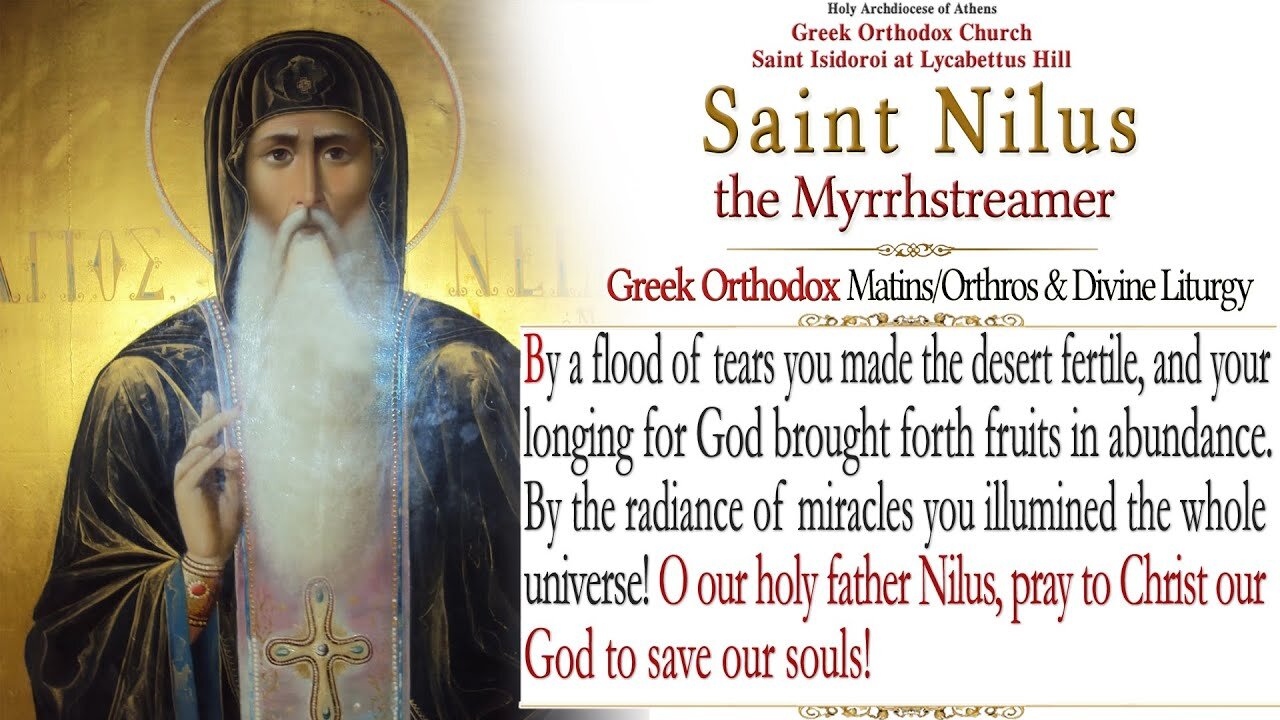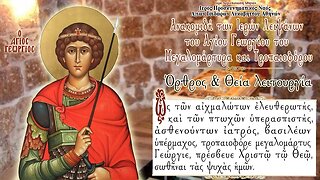Premium Only Content

November 12, 2021, Saint Nilus the Myrrh Streamer | Greek Orthodox Divine Liturgy Live Stream
Saint Nilus the Myrrh-Gusher of Mt Athos was born in Greece, in a village named for Saint Peter, in the Zakoneia diocese. He was raised by his uncle, the hieromonk Macarius. Having attained the age of maturity, he received monastic tonsure and was found worthy of ordination to hierodeacon, and then to hieromonk.
The desire for greater monastic struggles brought uncle and nephew to Mt Athos, where Macarius and Nilus lived in asceticism at a place called the Holy Rocks. Upon the repose of Saint Macarius, the venerable Nilus, aflame with zeal for even more intense spiritual efforts, found an isolated place almost inaccessible for any living thing. Upon his departure to the Lord in 1651, Saint Nilus was glorified by an abundant flow of curative myrrh, for which Christians journeyed from the most distant lands of the East.
Saint Nilus has left a remarkably accurate prophecy concerning the state of the Church in the mid-twentieth century, and a description of the people of that time. Among the inventions he predicted are the telephone, airplane, and submarine. He also warned that people’s minds would be clouded by carnal passions, “and dishonor and lawlessness will grow stronger.” Men would not be distinguishable from women because of their “shamelessness of dress and style of hair.” Saint Nilus lamented that Christian pastors, bishops and priests, would become vain men, and that the morals and traditions of the Church would change. Few pious and God-fearing pastors would remain, and many people would stray from the right path because no one would instruct them.
Watch live from the Greek Orthodox Church of Saint Isidoroi at Lycabettus hill, the Matins/Orthros and the Divine Liturgy. The small church of Saint Isidoroi belongs to the Holy Archdiocese of Athens and is located on the west side of Lycabettus Hill in Athens, built inside the largest cave on the hill. According to tradition, this cave was a place of ascetic life of the Christians of the first centuries.
-
 2:52:42
2:52:42
Greek Orthodox Church St. Isidoroi, Athens, Greece
2 years agoNovember 3, 2022, Transfer of Holy Relics of Martyr St. George | Greek Orthodox Divine Liturgy
741 -
 1:26:05
1:26:05
Glenn Greenwald
11 hours agoGOP Senators Demand Tulsi Support Domestic Surveillance To Be Confirmed; Group Tracks IDF War Criminals Around The World; System Pupdate: Pointer's Determination To Survive | SYSTEM UPDATE #387
126K74 -
 57:27
57:27
Flyover Conservatives
1 day agoHealthy People Are Ungovernable: The Secrets They Don’t Want YOU to Know - Tracy Beanz | FOC Show
64.8K7 -
 8:36:11
8:36:11
Dr Disrespect
18 hours ago🔴LIVE - DR DISRESPECT - DELTA FORCE - INTENSE SITUATIONS ONLY!
255K27 -
 4:01:30
4:01:30
Nerdrotic
15 hours ago $36.37 earnedHollywood National DISASTER! Studios Terrified, Star Wars FAIL | Friday Night Tights 336 w Raz0rfist
152K51 -
 2:52:10
2:52:10
Edge of Wonder
14 hours agoLA Fires: Biblical Inferno as Hollywood Burned Down
51.4K21 -
 12:35
12:35
China Uncensored
12 hours agoHas the Coverup Already Begun?
63K31 -
 1:09:12
1:09:12
The Big Mig™
16 hours agoLet’s Talk Music “Karmageddon” w/ Iyah May
48.9K8 -
 1:00:22
1:00:22
Sarah Westall
11 hours agoLoss of Confidence in the Medical System, Real Facts and Data w/ Dr. Michael Schwartz
49.6K5 -
 55:08
55:08
LFA TV
1 day agoThe Cause of ‘Natural’ Disasters | TRUMPET DAILY 1.10.25 7pm
41.6K14